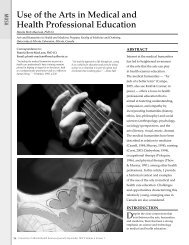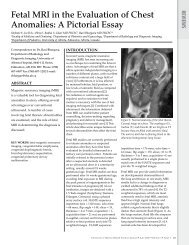Complete Issue PDF - University of Alberta Health Sciences Journal
Complete Issue PDF - University of Alberta Health Sciences Journal
Complete Issue PDF - University of Alberta Health Sciences Journal
- No tags were found...
You also want an ePaper? Increase the reach of your titles
YUMPU automatically turns print PDFs into web optimized ePapers that Google loves.
<strong>University</strong> <strong>of</strong> <strong>Alberta</strong> Summer Students’ Research DayIn 2011, over 200 undergraduate students participated in the Faculty <strong>of</strong> Medicine & Dentistry Summer StudentResearch Program. On October 15, 175 students presented posters at the 44th Annual Summer Students’ ResearchDay. Listed below are the 14 finalists from the poster competition. We congratulate the finalists and all participants.RESEARCHFrom these 14 finalists, two students were selected to represent the<strong>University</strong> <strong>of</strong> <strong>Alberta</strong> at the annual National Students’ ResearchForum in Galveston, Texas. Their abstracts are presented below.Uncovering the role <strong>of</strong> topoisomerase II-betabinding protein 1 in dna replication stress responseMark Assmus, Charles Leung, Mark GloverDNA replication stress can lead to genomic instability which hasbeen shown to be one <strong>of</strong> the primary hallmarks <strong>of</strong> cancer. TopBP1 is acrucial mediator protein found within the replication stress responsein mammalian cells. TopBP1 activates Ataxia telangiectasia mutatedrelated (ATR) kinase which phosphorylates many <strong>of</strong> the downstreamsubstrates to initiate this response. The replication stress responseinvolves specific interactions between the nine BRCA1 C terminus(BRCT) domains <strong>of</strong> TopBP1 and various proteins. More specifically,TopBP1 has been shown to provide an essential role in interactingwith both ATR-interacting protein (ATRIP), Rad9-Rad1-Hus1 (9-1-1)complex as well as Mediator <strong>of</strong> DNA damage checkpoint protein 1(MDC1) which are all essential components <strong>of</strong> the response pathway.The crystal structure <strong>of</strong> TopBP1 BRCT 4/5 in complex with MDC1 waspreviously solved in our lab. The structure shows a unique mode <strong>of</strong>TopBP1 binding to MDC1 that involves the dimerization <strong>of</strong> two BRCT4/5 molecules. In an effort to further examine this interaction, I useda fluorescence polarization (FP) binding assay involving an MDC1FITC labelled di-phospho-peptide. I was able to express and purifyGST fusion proteins <strong>of</strong> TopBP1 BRCT 4/5 and TopBP1 BRCT 5, as wellas TopBP1 BRCT 5 alone, which were used for further FP studies.The results <strong>of</strong> the FP assays indicated that it is the BRCT 5 bindingpocket which is primarily responsible for the interaction with MDC1and that the dimerization induced by GST allows for tighter binding.Additionally, mutant constructs <strong>of</strong> the putative BRCT 5 bindingpocket were designed, successfully over-expressed and purified.The FP assays showed decreases in binding affinity associated withmutation <strong>of</strong> key conserved residues in the binding pocket. FP wasalso used to confirm that the phosphorylation <strong>of</strong> the MDC1 peptideis essential for TopBP1 BRCT 4/5 recognition. Taken together, theseFP results further support the unique dimerization-based bindingmechanism suggested by the crystal structure.PAX3 expression in melanomaZachary Tan and D. Alan UnderhillThe transcription factor PAX3 is critical for development <strong>of</strong> neuralcrest lineages including melanocytes. Prior to birth, PAX3 isrequired for the proliferation <strong>of</strong> melanocyte precursors and it isthought to maintain an ‘undifferentiated plastic state’ in epidermalmelanocytes after birth, as well in melanocyte stem cells. Inaddition, PAX3 is expressed throughout melanoma progression,from nevi to metastatic disease. Nevertheless, little is known abouthow PAX3 carries out these diverse roles. PAX3 is reported to bephosphorylated by Glycogen Synthase Kinase 3ß (GSK3ß). In thepresent study, the potential role <strong>of</strong> this kinase in modulating PAX3activity in B16F10 melanoma cells was examined using chemicalinhibitors. Fluorescence Activated Cell Sorting (FACS) was usedto assess cell cycle distribution and PAX3 levels were monitoredby immunoblotting. Treatment <strong>of</strong> cells with the GSK3ß inhibitorslithium chloride (LiCl) or BIO caused decreased cell proliferation(P=0.05) and G2/M accumulation (P=0.05), and was associatedwith increased PAX3 expression (P=0.05). In contrast, knockdown<strong>of</strong> PAX3 using siRNA resulted in G1 accumulation (P=0.05).Immun<strong>of</strong>luorescence techniques for exogenous BrdU incorporationand endogenous PS10H3 allowed for direct microscopic visualizationand quantification <strong>of</strong> cells in S and G2/M phase respectively. UponPAX3 knockdown, there was significantly less BrdU incorporationand PS10H3 staining (P=0.05). Lastly, cell motility assays wereconducted using live-cell Differential Interference Contrast (DIC)microscopy and analyzed using T-Scratch s<strong>of</strong>tware. Interestingly,inhibition <strong>of</strong> GSK3ß as well as PAX3 knockdown was associatedwith markedly decreased cellular motility and proliferation. Theseinvestigations identify GSK3ß and as an important modulator <strong>of</strong>PAX3 levels in melanoma cells, and also suggest broader roles forPAX3 in regulating the G1 to S-phase transition in melanoma.Student Poster Title SupervisorMark AssmusChristopherBeavingtonAlannaChomynNicholas ChuaAlexandruCojocaruMichelinaKierzekStephanie MahScott MeyerRobyn MillottKian ParseyanAmit PersadRaheemSulemanUncovering the role <strong>of</strong> topoisomerase II-betabinding protein 1 in DNA replication stressresponseThe structural studies <strong>of</strong> bacterial lact<strong>of</strong>errinbinding protein B from Neisseria meningitidesIsolation <strong>of</strong> trkA expressing and IB4-bindingsensory neurons through the use <strong>of</strong> saporinA model system for complex redox enzymematurationUsing inhibition <strong>of</strong> protein N-myristoylationtowards the design <strong>of</strong> a synthetically lethaltreatment <strong>of</strong> B-cell lymphomasElucidating the molecular mechanisms<strong>of</strong> heart disease-linked mutations <strong>of</strong>phospholambanCapase 1 Inhibition in inflammatory boweldisease reduces epithelial cell extrusionInvestigating the quinone binding site <strong>of</strong>Escherichia coli fumarate reductaseThe novel interaction betweenN-myristoyltransferase 1 and calnexinProposed improvements for intraspinalmicrostimulation array fabrication andinsertionExpression <strong>of</strong> ST8Sia family in developingchick retina and their role in AP2deltamediatedaxonal generationDoes long life come from mom? Isolation <strong>of</strong>a longevity-conferring mitochondrial DNAmutation in Caenorhabditis elegansDr. Mark GloverDr. Joanne LemieuxDr. Christine WebberDr. Joel H. WeinerDr. Luc G.BerthiaumeDr. Howard S. YoungDr. Julia LiuDr. Joel H. WeinerDr. Marek MichalakDr. Vivian K.MushahwarDr. Roseline GodboutDr. Bernard D.LemireDepartment/DivisionBiochemistryBiochemistryAnatomyBiochemistryCell BiologyBiochemistryMedicine/GastroenterologyBiochemistryBiochemistryCell BiologyOncologyBiochemistryZachary Tan PAX3 expression in melanoma Dr. Alan Underhill OncologyTerri WallerPartial deficiency <strong>of</strong> adipose trigylceridelipase (atgl) does not protect againstdiabetes-induced cardiac dysfunctionDr. Jason R.B. DyckPediatrics<strong>University</strong> <strong>of</strong> <strong>Alberta</strong> <strong>Health</strong> <strong>Sciences</strong> <strong>Journal</strong> • April 2012 • Volume 7 • <strong>Issue</strong> 1 3






